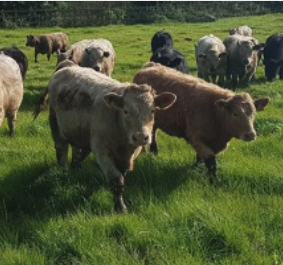Drive your Animal’s Performance this Autumn with Drummonds Feeds -
From late June to October, a substantial number of beef cattle will be slaughtered off grass. Slaughtering cattle at this time of year has a number of advantages including lower cost of production with less meal input, cheaper weight gain off grass, and heavier carcasses. Generally, animals killed in early summer benefit from a price rise also.
Pushing heavy cattle to finish off grass is economically attractive against the costs associated with winter housed feeding. Feeding meal on farms where grass supply is tight will benefit in terms of a reduced grass demand and increased animal performance. Carcass growth response to concentrate supplementation at pasture is higher where grass supply is low and where grass quality is poorer.
Now is the time to assess your stock and decide which route to go with your heavier store cattle. Grass quality at this time of year tends to reduce compared to spring / summer grass, with Dry Matter (DM) content typically of 12-16% and the energy content reducing as the year progresses. Supplement to ensure a minimum of 1kg liveweight gain per day is achieved.

Responses to feeding cattle 4kg of meal at grass:
- Daily gain: +0.2-0.3 kg/day
- Kill out: +0.5-1.5%
- Carcass: +35-40kg
- Confirmation: +0.2-0.8-unit increase
- Fat: 1-1.5-unit increase.
Teagasc feeding trials completed at Teagasc Grange indicate that there is an economic response to feeding 0.5kg concentrates per 100kg liveweight (e.g. 3kg of ration to a 600kg animal) where grass is plentiful and 1kg concentrates per 100kg liveweight (e.g. 6kg ration to a 600nkg animal) where grass is scarce. Drummonds have a comprehensive range of top quality coarse and cube rations available.
Planning Fodder for the Winter
 It is also important for farmers to plan their fodder for next winter, if not already done so. With a lot of feed used up on farms last winter, and fodder being fed throughout the summer to supplement grass shortages, it is essential for farmers to plan ahead to prevent any further shortages. The table below can be used to calculate the fodder demand on your farm. The winter housing period depends on the part of the country you are in. Review the average time cattle are spending indoors on your farm and add a month’s fodder reserve to this time period as a buffer. To measure pit silage measure length x width x height in metres and divide by 1.4 (this is allowing for pit silage at 22% DM) and measure bales at 700kg on average.
It is also important for farmers to plan their fodder for next winter, if not already done so. With a lot of feed used up on farms last winter, and fodder being fed throughout the summer to supplement grass shortages, it is essential for farmers to plan ahead to prevent any further shortages. The table below can be used to calculate the fodder demand on your farm. The winter housing period depends on the part of the country you are in. Review the average time cattle are spending indoors on your farm and add a month’s fodder reserve to this time period as a buffer. To measure pit silage measure length x width x height in metres and divide by 1.4 (this is allowing for pit silage at 22% DM) and measure bales at 700kg on average.
What fodder is required on the farm?

To contact your local Drummonds Agronomist / Branch - Click Here


